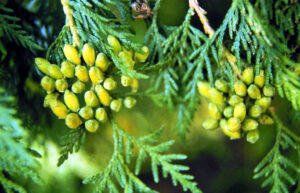ALTERNATIVE THERAPEUTIC EFFICACY OF THUJA OCCIDENTALIS FOR WART RELATED MASTITIS IN CATTLE
- S. D. GAYAL* DR. MEERA P. SAKHARE1
* M.V.Sc. Scholar
1 Assistant Professor
Department of Veterinary Preventive Medicine,
COVAS, MAFSU, Parbhani, Maharashtra, India
ABSTRACT
Mastitis is one of the most commonly encountered disease in dairy cows and responsible for the extreme economic losses in dairy farms. Clinical symptoms of mastitis may be vague in cases of viral infection, with prominent other clinical symptoms. Subclinical mastitis cases cannot be generally detected and as a consequence, they are not studied very well. There are many viral agents associated with bovine mastitis and which may cause subclinical mastitis in dairy cattle. Bovine Parainfluenza-3 (BPIV-3), Bovine Papillomaviruses (BPV), Bovine Herpesvirus 1 (BHV-1) could cause clinical and subclinical mastitis. The most common treatment method available against bovine mastitis is the intra-mammary infusion of antibiotics. However, their use is allied with the problem of antimicrobial resistance. Medicinal plants with their well-established history are an excellent natural product resource used as an alternative therapy. This scenario has made search for alternative treatment for bovine mastitis.
Keywords: Subclinical mastitis, Wart, Thuja Occidentalis, Homeopathy
INTRODUCTION:
Cows are considered holy to the people of Hindu faith across the Indian subcontinent. It is known as Kamadhenu, or divine cow, and the contributor of all needs. The Hindu religion knows the rights of animals to co-exist with humans; therefore, people are taught to love, nurture and worship them. From a source of milk to a provider of labour and religious inspiration, cows often play a prominent role in Hindu society. Cow’s milk is a good source of protein and calcium, as well as nutrients including vitamin B12 and iodine. It also contains magnesium, which is important for bone development and muscle function, and whey and casein, which have been found to play a role in lowering blood pressure.
Among the animal diseases which affect the profitability of rearing animals, mastitis is considered to be one of the expensive diseases in terms of production losses. Mastitis is a common disease entity of dairy cows, accompanied by physical, chemical, pathological and bacteriological changes in milk and glandular tissue. The disease is usually classified as subclinical, acute, subacute and chronic based on aetio-pathological findings and observations. Mastitis in domestic dairy cattle causes economic losses. The economic problems caused by mastitis are related to direct and indirect losses.
The majority of mastitis cases are bacterial and other infections such as mycoplasms, fungi, yeasts, virus, and chlamydia. Mastitis is divided into clinical and subclinical form. In clinical mastitis, the risk of contamination can be stopped to separate the animal from the herd, but the subclinical mastitis continues to flock because the animal does not show clinical signs and symptoms, and mastitis causes the other animals to catch up. As a result, the economic losses are getting bigger. The subclinical form of mastitis in dairy cows is important because this form 15 to 40 times more prevalent than the clinical form usually precedes the clinical form, of long duration and difficult to detect. There are many viral agents associated with bovine mastitis and which may cause or play important role in subclinical mastitis in dairy cattle.
Bovine Herpesvirus (BHV-1), Bovine Parainfluenza 3 (BPIV-3) virus, Bovine Papillomaviruses could cause or play a role in clinical and subclinical mastitis. The Bovine Papilloma viruses (BPV) belong to the Papillomaviridae family. BPV-1, BPV-2, and BPV-13 can infect and cause the development of teat tumor in cattle. BPV can cause the fibropapillomas in the ductus papillaris, this virus could demonstrate a predisposition in cattle with mastitis. Six types of BPV have been characterized, of which BPV-1 cause frond fibropapilloma of udder and teat, BPV type 1-11can cause teat warts in dairy cattle. BPV-5 cause rice grain fibropapilloma of udder and BPV-6 cause frond epithelial papilloma of the bovine udder and teat. In cattle, bovine papilloma virus (BPV) is the causative agent of cutaneous and teat papillomatosis, cancers of the upper gastrointestinal tract and urinary bladder. The papilloma virus, which usually appear as multiple, sessile or pedunculated, circumscribed grey white to dark brownish black outgrowth may appear on skin over different body parts. However, neck, eyelids, teats and lower line of abdomen are the most common sites. It is a contagious disease, usually transmitted via direct contact, contaminated food and equipment, flies, castration and injections. Papillomas on teats may cause difficulty in milking and suckling by calf and sometimes, pedunculated papillomas snap-off causing mastitis and teat infections.
However, since viral infections have not been much investigated in mastitis studies, strategies developed against subclinical mastitis may be inadequate. Treatment of mastitis mainly relies on antibiotics. However, the long-term use of antibiotics in dairy cows has led to increased drug resistance of the pathogens causing mastitis. Therefore, alternative methods for the elimination of pathogenic microorganisms causing mastitis are being investigated. Such methods include the use of nanotechnology, bacteriophage therapy, plant extracts, proteins of animal origin and bacteriocins. The main advantage of these solutions is that pathogens do not become resistant to the substances used. Thus, they may in the future become the main forms of mastitis therapy. In vitro and in vivo studies of alternative treatments for mastitis have revealed successful inhibition of growth and destruction of many pathogens responsible for this disease. Antibacterial agents from plants can act as important sources of novel antibiotics, efflux pump inhibitors, compounds that target bacterial virulence or can be used in combination with existing drugs. The plants form an essential component of ethno-veterinary medicine used in the treatment of different diseases like bovine mastitis.
CASE HISTORY AND DIAGNOSIS:
A six year old pregnant Jersey cross bred cow (Fig. 1) was referred to Department of Veterinary Medicine, COVAS, Parbhani with the history of skin lesions on udder and teat with swollen udder. While milking due to skin lesions on udder get ruptured from udder makes difficulty in milking. After clinical examination revealed filiform type cutaneous warts on all teats (Fig. 2 & 3).
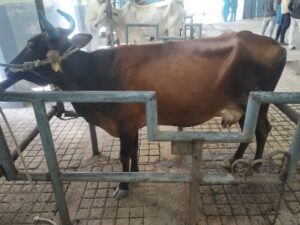
Fig.1: Jersey cross bred cow presented to clinic |
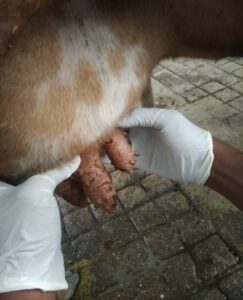
Fig.2 : Multiple cutaneous growths on udder and teat |
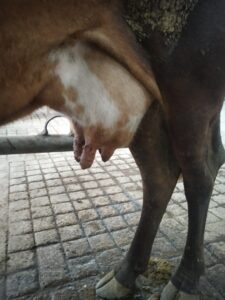
|
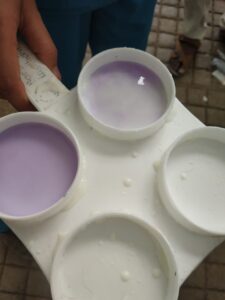 |
| Fig.3 : Papilloma lesions on teat of cow | Fig.4 : positive CMT test of cow |
The physiological parameters like temperature, heart and respiration rate was within the normal range. Physical examination of milk revealed normal colour, odour and consistency. California Mastitis Test revealed gel formation adhering to CMT plate (Fig. 4). As per history, detail clinical examination, CMT test, typical clinical lesions of wart, the case was diagnosed as subclinical mastitis along with bovine teat papillomatosis.
TREATMENT AND DISCUSSION:
The cow was treated with Inj. Ceftriaxone- Tazobactum @10 mg/kg bw im, Inj. Meloxicam @ 0.5mg/kg bw im, Inj. Chlorphenaramine maleate @ 0.5mg/kg bw im for 3 days. Thuja occidentalis (Thuja-30) @ 10 drops orally BID and Thuja ointment locally BID for 3 weeks. It was advised to used by adding 10 drops on a lump of Jaggery orally twice a day for 15 days and asked the owner to get their cow reviewed after 4 weeks of treatment. After 2nd week of treatment regression of nodule noticed (Fig.5). After treatment, the papilloma growths showed signs of regression. Whereas, after 3rd week of treatment, teat becomes soft on palpation and regressed nodules observed (Fig.6) and only light black colored scars were seen at the sight of the growth . The animal was under observation for four weeks after therapy with negative Calfornia Mastitis Test. By the end of four weeks all the papilloma growths were completely disappeared with normal milk secretion.
Thuja occidentalis is a quite common small doom shaped plant found in orchards or gardens. Thuja-30 potency drug was prepared from the mother tincture of its leaves. Papillomatous warts are especially menable to this drug (Fig. 9). It is indicated for the treatment of polyp and epithelioma. This wonderful effect may be ascribed to its various chemical constituents i.e. Dextro-pinene, Dextro- thujone, thujine, laevo-fenchone and pinpierin. Plant derivative homoeopathic preparation available in market with a brand name of Thuja-30 for humans. BPV-1 and 10 are involved in production of rice grain-like and sessile elevated growths on the teats of cattle. Teat papillamatosis can be cured more efficiently when Levamisole given in treatment along with auto-hemotherapy without using any chemical agent, auto-hemotherapy can be effectively employed to treat bovine teat papillomatosis.
Mastitis is the most common disease in dairy cows and alternative solutions to antibiotics have to be found for its treatment. The growing resistance to antibiotics in pathogens causing mastitis decreases the effectiveness of treatment and often leads to preterm culling of cows that cannot be cured, resulting in huge financial losses for dairy farms.
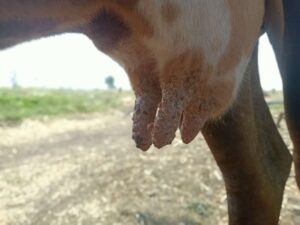 |
 |
| Fig.5: Regression of nodules
(after 2nd week of treatment) |
Fig.6: Regression of nodules
(after 3rd week of treatment) |
 |
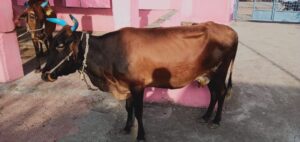 |
| Fig.7: Complete Recovery of warts on teat
(after 4th week of treatment) |
Fig.8: Complete Recovery of cow |
Fig. 9: Thuja occidentalis – Leaves and immature cones
CONCLUSION:
Alternative therapy with Thuja occidentalis for wart related subclinical mastitis was done successfully without any untoward reaction.
REFERENCES:
- Radostits, O. M., Gay, C. C., Hinchcliff, K. W. and P. D. Constable (2007) Veterinary Medicine- A text book of the diseases of horse, sheep, goat and cattle, 10th
- Merck (2008) The Merck Veterinary Manual. 8th Edn. Merck & CO., INC. Whitehouse station, N.J. USA.
- Shakoor, A., Muhammad, S. A., Kashif, M., Rehman, Z. U., Hussain, A., and M. R. Hameed (2012) Effects of Thuja Occidentalis as an alternative remedy in the treatment of Papillomatosis in Cattle. Veterinary World. 5(2):118.
- Odhah, M. N., Sabri, J., Reduan, M. F. H., Garba, B., Che, S. N., Yahya, E. L. T. C., and MS, N. I. (2021) International Journal of Veterinary Science.
- Bhavana, V. and N. G. Sagar (2021) Case study on papillomatosis in a calf and its therapy. The Pharma Innovation Journal.10(5S): 664-666.




